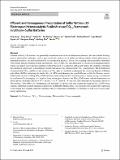| dc.contributor.author | Feng, Ping | |
| dc.contributor.author | Dong, Kang | |
| dc.contributor.author | Xu, Yaolin | |
| dc.contributor.author | Zhang, Xia | |
| dc.contributor.author | Jia, Haojun | |
| dc.contributor.author | Prell, Henrik | |
| dc.contributor.author | Tovar, Michael | |
| dc.contributor.author | Manke, Ingo | |
| dc.contributor.author | Liu, Fuyao | |
| dc.contributor.author | Xiang, Hengxue | |
| dc.contributor.author | Zhu, Meifang | |
| dc.contributor.author | Lu, Yan | |
| dc.date.accessioned | 2024-03-25T15:30:47Z | |
| dc.date.available | 2024-03-25T15:30:47Z | |
| dc.date.issued | 2024-03-18 | |
| dc.identifier.issn | 2524-7921 | |
| dc.identifier.issn | 2524-793X | |
| dc.identifier.uri | https://hdl.handle.net/1721.1/153930 | |
| dc.description.abstract | Lithium–sulfur (Li–S) batteries can potentially outperform state-of-the-art lithium-ion batteries, but their further development is hindered by challenges, such as poor electrical conductivity of sulfur and lithium sulfide, shuttle phenomena of lithium polysulfides, and uneven distribution of solid reaction products. Herein, free-standing carbon nanofibers embedded with oxygen-deficient titanium dioxide nanoparticles (TiO2-x/CNFs) has been fabricated by a facile electrospinning method, which can support active electrode materials without the need for conductive carbon and binders. By carefully controlling the calcination temperature, a mixed phase of rutile and anatase was achieved in the TiO2-x nanoparticles. The hybridization of anatase/rutile TiO2-x and the oxygen vacancy in TiO2-x play a crucial role in enhancing the conversion kinetics of lithium polysulfides (LiPSs), mitigating the shuttle effect of LiPSs, and enhancing the overall efficiency of the Li–S battery system. Additionally, the free-standing TiO2-x/CNFs facilitate uniform deposition of reaction products during cycling, as confirmed by synchrotron X-ray imaging. As a result of these advantageous features, the TiO2-x/CNFs-based cathode demonstrates an initial specific discharge capacity of 787.4 mAh g−1 at 0.5 C in the Li–S coin cells, and a final specific discharge capacity of 584.0 mAh g−1 after 300 cycles. Furthermore, soft-packaged Li–S pouch cells were constructed using the TiO2-x/CNFs-based cathode, exhibiting excellent mechanical properties at different bending states. This study presents an innovative approach to developing free-standing sulfur host materials that are well suited for flexible Li–S batteries as well as for various other energy applications.
Graphical Abstract | en_US |
| dc.publisher | Springer Nature Singapore | en_US |
| dc.relation.isversionof | 10.1007/s42765-024-00380-1 | en_US |
| dc.rights | Creative Commons Attribution | en_US |
| dc.rights.uri | https://creativecommons.org/licenses/by/4.0/ | en_US |
| dc.source | Springer Nature Singapore | en_US |
| dc.subject | Polymers and Plastics | en_US |
| dc.subject | Materials Chemistry | en_US |
| dc.subject | Electronic, Optical and Magnetic Materials | en_US |
| dc.subject | Materials Science (miscellaneous) | en_US |
| dc.title | Efficient and Homogenous Precipitation of Sulfur Within a 3D Electrospun Heterocatalytic Rutile/Anatase TiO2-x Framework in Lithium–Sulfur Batteries | en_US |
| dc.type | Article | en_US |
| dc.identifier.citation | Feng, P., Dong, K., Xu, Y. et al. Efficient and Homogenous Precipitation of Sulfur Within a 3D Electrospun Heterocatalytic Rutile/Anatase TiO2-x Framework in Lithium–Sulfur Batteries. Adv. Fiber Mater. (2024). https://doi.org/10.1007/s42765-024-00380-1 | en_US |
| dc.contributor.department | Massachusetts Institute of Technology. Department of Chemistry | |
| dc.relation.journal | Advanced Fiber Materials | en_US |
| dc.identifier.mitlicense | PUBLISHER_CC | |
| dc.eprint.version | Final published version | en_US |
| dc.type.uri | http://purl.org/eprint/type/JournalArticle | en_US |
| eprint.status | http://purl.org/eprint/status/PeerReviewed | en_US |
| dc.date.updated | 2024-03-24T04:18:07Z | |
| dc.language.rfc3066 | en | |
| dc.rights.holder | The Author(s) | |
| dspace.embargo.terms | N | |
| dspace.date.submission | 2024-03-24T04:18:07Z | |
| mit.license | PUBLISHER_CC | |
| mit.metadata.status | Authority Work and Publication Information Needed | en_US |
